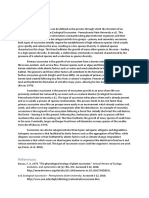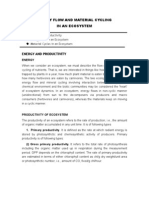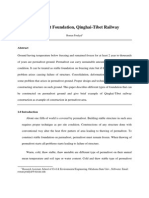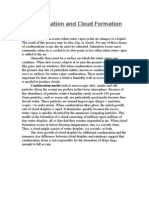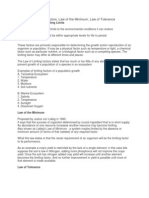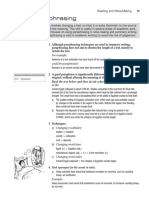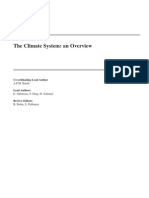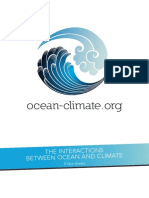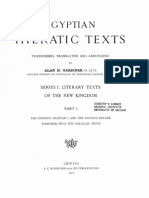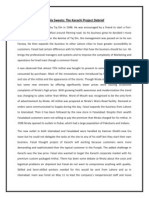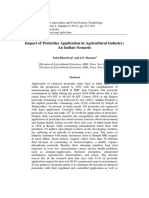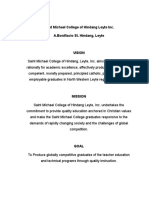Natural Resource
Natural Resource
Uploaded by
Yuli Macias VivancoCopyright:
Available Formats
Natural Resource
Natural Resource
Uploaded by
Yuli Macias VivancoCopyright
Available Formats
Share this document
Did you find this document useful?
Is this content inappropriate?
Copyright:
Available Formats
Natural Resource
Natural Resource
Uploaded by
Yuli Macias VivancoCopyright:
Available Formats
NATURAL RESOURCE
A natural resource is anything people can use which comes from nature. People do not make natural resources, but gather them from the earth. Examples of natural resources are air, water, wood, oil, solar energy, wind energy, hydroelectric energy, and coal. Refined oil is not a natural resource because people make it. We often say there are two sorts of natural resources: renewable resources and non-renewable resources. A renewable resource grows again or comes back again after we use it. For example, sunlight, water and wood are renewable resources. A non-renewable resource is a resource that does not grow or come back, or a resource that would take a very long time to come back. For example, coal is a non-renewable resource.
RENEWABLE RESOURCE A substance of economic value that can be replaced or replenished in the same amount or less time as it takes to draw the supply down. Some renewable resources have essentially an endless supply, such as solar energy, wind energy and geothermal pressure, while other resources are considered renewable even though some time or effort must go into their renewal, such as wood, oxygen, leather and fish. Most precious metals are considered renewable as well; even though they are not naturally replaced, they can be recycled because they are not destroyed during their extraction and use. Renewable resources have become a focal point of the environmental movement, both politically and economically. Energy obtained from renewable resources puts much less strain on the limited supply of fossil fuels (nonrenewable resources). The problem with using renewable resources on a large scale is a cost problem and in most cases, more research is needed to make their use cost-effective.
RENEWABLE RESOURCE A renewable resource is a resource which is replaced naturally. Examples are: oxygen, fresh water, solar energy, timber, and biomass. They may become non-renewable resources if more is used than nature can replace in time. For example, ground water may be removed from an aquifer faster than new water replacing it. Drought might follow. Renewable resources may also include goods commodities such as wood, paper and leather. Gasoline, coal, natural gas, diesel and other commodities that come from fossil fuels are non-renewable. Some commodities, like plastics and diesel, are mostly made from fossil fuel. However, ways have been developed to make degradable plastic and biodiesel from renewable resources such as corn, soybeans and canola.
You might also like
- Lesson Plan Multigrade 1&2Document30 pagesLesson Plan Multigrade 1&2Anonymous pN9oFMD185% (13)
- Renewable Energy Basics BGDocument6 pagesRenewable Energy Basics BGErwin NurrizkiNo ratings yet
- 132 KV DifferentialDocument23 pages132 KV DifferentialdilipelineNo ratings yet
- Emphasis On The Overall Conditions Present During The Specific Geologic Period Geological Period: Precambrian ADocument3 pagesEmphasis On The Overall Conditions Present During The Specific Geologic Period Geological Period: Precambrian AColline AtanacioNo ratings yet
- Midterm-Types of Clouds in The Sky Lesson PlanDocument6 pagesMidterm-Types of Clouds in The Sky Lesson Planapi-252841905No ratings yet
- Renewable and Nonrenewable Energy Sources Text TuesdayDocument3 pagesRenewable and Nonrenewable Energy Sources Text Tuesdayapi-293084509No ratings yet
- Depletion of Natural ResourcesDocument6 pagesDepletion of Natural ResourcesHaseeb MoledinaNo ratings yet
- A Cultural Analysis of American Indian Advertisements 1Document39 pagesA Cultural Analysis of American Indian Advertisements 1Rabara Aelis100% (1)
- Arid LandformsDocument43 pagesArid LandformsNarmatha BalachandarNo ratings yet
- Anatomy of A Subduction ZoneDocument1 pageAnatomy of A Subduction ZonecvytasekNo ratings yet
- Ecological SuccessionDocument2 pagesEcological SuccessionNicholas LalaiNo ratings yet
- Climate Change Impacts On Biodiversity-The Setting of A Lingering Global CrisisDocument10 pagesClimate Change Impacts On Biodiversity-The Setting of A Lingering Global CrisisRin FitriaNo ratings yet
- Mass WastingDocument64 pagesMass WastingEkala XuhalxNo ratings yet
- Precambrian Time Divided IntoDocument1 pagePrecambrian Time Divided IntoElvira YabutNo ratings yet
- Lecture 9 Desert Features and Landforms PDFDocument4 pagesLecture 9 Desert Features and Landforms PDFaliNo ratings yet
- Introduction To Pollution PreventionDocument24 pagesIntroduction To Pollution PreventionSandip KadoliNo ratings yet
- Fossil Fuel ResourceDocument2 pagesFossil Fuel Resourcesaeed jamalNo ratings yet
- Poverty Has A Woman's FaceDocument5 pagesPoverty Has A Woman's FaceJennibeth100% (1)
- Non Conventional Sources of EnergyDocument13 pagesNon Conventional Sources of EnergyAditya Kumar100% (1)
- Evidence of Ancient Glaciation in Jharkhand State - of India.Document5 pagesEvidence of Ancient Glaciation in Jharkhand State - of India.Dr. Nitish PriyadarshiNo ratings yet
- EcoDocument4 pagesEcoshivothamanNo ratings yet
- Lake StratificationDocument3 pagesLake Stratificationsagar dasguptaNo ratings yet
- President Obama 2012 Victory SpeechDocument6 pagesPresident Obama 2012 Victory Speechapi-291574045No ratings yet
- 1.4 Energy FlowDocument7 pages1.4 Energy FlowRathnavel Ponnuswami100% (1)
- 16.3 Darwin Presents His CaseDocument25 pages16.3 Darwin Presents His CaseAlex BeilmanNo ratings yet
- Permafrost FoundationDocument16 pagesPermafrost FoundationrppoudyalNo ratings yet
- StratigrafiDocument22 pagesStratigrafiAdityaMangalaNo ratings yet
- Condensation and Cloud FormationDocument17 pagesCondensation and Cloud FormationIyah Macam100% (1)
- EPS 50 Lab 4: Sedimentary Rocks: Grotzinger and Jordan, Chapter 5Document7 pagesEPS 50 Lab 4: Sedimentary Rocks: Grotzinger and Jordan, Chapter 5Abood BuriahiNo ratings yet
- Types of BiomeDocument8 pagesTypes of Biomelizzie_mcgNo ratings yet
- 1 Definition and Origin of MagmaDocument17 pages1 Definition and Origin of MagmaAtharNo ratings yet
- Biomes of The WorldDocument13 pagesBiomes of The WorldAsad AliNo ratings yet
- Law of The Limiting FactorsDocument4 pagesLaw of The Limiting FactorsBiswajit DarbarNo ratings yet
- Weathering and Soil - Geology inDocument4 pagesWeathering and Soil - Geology inJair RosasNo ratings yet
- Biogeochemical CyclesDocument2 pagesBiogeochemical CyclesAbi Diciembre BrionesNo ratings yet
- Paraphrasing PDFDocument2 pagesParaphrasing PDFammaranas100% (1)
- Formation of Sedimentary RocksDocument2 pagesFormation of Sedimentary RocksIzhar Jiskani100% (1)
- Formation of Sedimentary RocksDocument12 pagesFormation of Sedimentary RocksBalqis yasin100% (1)
- IX. Fundamentals of English LexicographyDocument12 pagesIX. Fundamentals of English LexicographyDariaNo ratings yet
- Species DiversityDocument5 pagesSpecies Diversityapi-296317938No ratings yet
- Fixity of SpeciesDocument8 pagesFixity of Species'Lab Qou'No ratings yet
- EarthquakeDocument42 pagesEarthquakeNarayan JariwalaNo ratings yet
- The Climate System: An Overview: Co-Ordinating Lead AuthorDocument14 pagesThe Climate System: An Overview: Co-Ordinating Lead AuthorAlina SurubaruNo ratings yet
- BiomesDocument26 pagesBiomesMariyam SiddiquiNo ratings yet
- Local and Regional Wind SystemsDocument15 pagesLocal and Regional Wind SystemscptmehmetkaptanNo ratings yet
- Glacier Outline CheatsheetDocument4 pagesGlacier Outline Cheatsheetbohongnih67% (3)
- Bottleneck EffectDocument2 pagesBottleneck EffectkloaizarNo ratings yet
- Contact MetamorphismDocument3 pagesContact MetamorphismAlexandru StefanNo ratings yet
- Effects of Water PollutionDocument5 pagesEffects of Water PollutionWei ChongNo ratings yet
- Ways of Making Up New Compound Words in English and Their Main PecualaritiesDocument47 pagesWays of Making Up New Compound Words in English and Their Main PecualaritiesAnna SasuNo ratings yet
- Water ResourcesDocument27 pagesWater Resourcessharon ranjitha paulNo ratings yet
- TundraDocument15 pagesTundraMily Leal100% (1)
- Tides and Lunar PhasesDocument16 pagesTides and Lunar Phasesapi-291717107No ratings yet
- Life Cycle of A StarDocument29 pagesLife Cycle of A StarCharmine Abuan - BayanitoNo ratings yet
- Ocean and ClimateDocument18 pagesOcean and ClimateSiti hawaNo ratings yet
- Burning Environmental Issues of Assam or North-EastDocument15 pagesBurning Environmental Issues of Assam or North-EastS.K. Chaliha100% (6)
- Biomes Zonation and SuccessionDocument43 pagesBiomes Zonation and Successionjulia wolfmanNo ratings yet
- Milankovitch CyclesDocument3 pagesMilankovitch CyclesHJakansjakkaNo ratings yet
- DRM (Natural and Anthropogenic HazardsDocument47 pagesDRM (Natural and Anthropogenic HazardsTamia ShoaibNo ratings yet
- SSt ELPDocument11 pagesSSt ELPSoftwarez TechnocrewNo ratings yet
- SstDocument11 pagesSstSoftwarez TechnocrewNo ratings yet
- R UNIT 3 LESSON 2 The State of Natural Resources Management-1Document4 pagesR UNIT 3 LESSON 2 The State of Natural Resources Management-1BEATphNo ratings yet
- Data Collection NormalizationDocument6 pagesData Collection Normalizationnaren.bansalNo ratings yet
- Strategic Management-Module-1Document44 pagesStrategic Management-Module-1Mahesh RangaswamyNo ratings yet
- Group 1 - Tata NanoDocument19 pagesGroup 1 - Tata NanoPalak SinghalNo ratings yet
- Roofing SystemDocument3 pagesRoofing SystemFrancis Prudenciado100% (1)
- Consolidated Annexure 1 To 8Document161 pagesConsolidated Annexure 1 To 8Sandeep BadoniNo ratings yet
- Kyle Lit Review Pop CultureDocument4 pagesKyle Lit Review Pop CultureCyril CauilanNo ratings yet
- IAM Unit 4 MCQDocument4 pagesIAM Unit 4 MCQVishal SawantNo ratings yet
- Allocation of Cash Dividends Between Preference Share and Ordinary ShareDocument2 pagesAllocation of Cash Dividends Between Preference Share and Ordinary Shareshaina.planco4No ratings yet
- Describe Your City/neighborhood/countryDocument3 pagesDescribe Your City/neighborhood/countryalexander lealNo ratings yet
- Gardiner - Egyptian Hieratic TextsDocument143 pagesGardiner - Egyptian Hieratic TextsKen Griffin100% (2)
- Nirala SweetsDocument2 pagesNirala SweetsQaiserNo ratings yet
- Industrial Single Board Computer: Express MotherboardDocument2 pagesIndustrial Single Board Computer: Express MotherboardARTURO DE LA VEGANo ratings yet
- Manage Service Manager AccentureDocument3 pagesManage Service Manager Accenturec6c4pmyh8cNo ratings yet
- APPLICATIONDocument35 pagesAPPLICATIONRonald Jay LacisteNo ratings yet
- Narrative Interview Essay ExampleDocument8 pagesNarrative Interview Essay Examplecsmvbxwhd100% (2)
- Abbottabad: City Wise S. No. Name Address Phone NoDocument4 pagesAbbottabad: City Wise S. No. Name Address Phone NoQasimMalikNo ratings yet
- Designing and Managing Services: A Case StudyDocument42 pagesDesigning and Managing Services: A Case StudySuha Fathimath100% (1)
- How To Make A Cheap Solar Usb ChargerDocument5 pagesHow To Make A Cheap Solar Usb Chargerhernan1970No ratings yet
- Impact of Pesticides Application in Agricultural Industry: An Indian ScenarioDocument6 pagesImpact of Pesticides Application in Agricultural Industry: An Indian Scenarioوهيب حسن الحذوريNo ratings yet
- Fake News DetectionDocument44 pagesFake News Detectionaravind100% (1)
- HR Planing 01Document35 pagesHR Planing 01Amit100% (2)
- Module 1 WorkbookDocument10 pagesModule 1 Workbooktempmail432165No ratings yet
- Silk Road English Project cls11Document6 pagesSilk Road English Project cls11Praneeth ReddyNo ratings yet
- NARRATIE REPORT rOXANNEDocument13 pagesNARRATIE REPORT rOXANNEAdrian Paul AstorgaNo ratings yet
- Understanding The Self Module 2 The Self Society and CultureDocument10 pagesUnderstanding The Self Module 2 The Self Society and CultureKrisChan ProdNo ratings yet
- Way of The BirdDocument232 pagesWay of The Birdaskey69100% (1)
- WorkshopDocument5 pagesWorkshopJoseph NjugunaNo ratings yet
- Benadryl Allergy Children's 1mg - ML Oral Solution - Summary of Product Characteristics (SMPC) - Print Friendly - (Emc)Document8 pagesBenadryl Allergy Children's 1mg - ML Oral Solution - Summary of Product Characteristics (SMPC) - Print Friendly - (Emc)WenChin FooNo ratings yet










